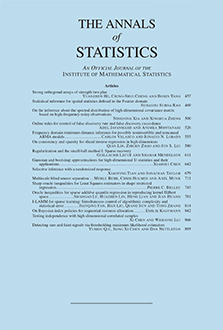Abstract
We consider a model problem of recovering a function $f(x_1,x_2)$ from noisy Radon data. The function $f$ to be recovered is assumed smooth apart from a discontinuity along a $C^2$ curve, that is, an edge. We use the continuum white-noise model, with noise level $\varepsilon$.
Traditional linear methods for solving such inverse problems behave poorly in the presence of edges. Qualitatively, the reconstructions are blurred near the edges; quantitatively, they give in our model mean squared errors (MSEs) that tend to zero with noise level $\varepsilon$ only as $O(\varepsilon^{1/2})$ as $\varepsilon\to 0$. A recent innovation--nonlinear shrinkage in the wavelet domain--visually improves edge sharpness and improves MSE convergence to $O(\varepsilon^{2/3})$. However, as we show here, this rate is not optimal.
In fact, essentially optimal performance is obtained by deploying the recently-introduced tight frames of curvelets in this setting. Curvelets are smooth, highly anisotropic elements ideally suited for detecting and synthesizing curved edges. To deploy them in the Radon setting, we construct a curvelet-based biorthogonal decomposition of the Radon operator and build "curvelet shrinkage" estimators based on thresholding of the noisy curvelet coefficients. In effect, the estimator detects edges at certain locations and orientations in the Radon domain and automatically synthesizes edges at corresponding locations and directions in the original domain.
We prove that the curvelet shrinkage can be tuned so that the estimator will attain, within logarithmic factors, the MSE $O(\varepsilon^{4/5})$ as noise level $\varepsilon\to 0$. This rate of convergence holds uniformly over a class of functions which are $C^2$ except for discontinuities along $C^2$ curves, and (except for log terms) is the minimax rate for that class. Our approach is an instance of a general strategy which should apply in other inverse problems; we sketch a deconvolution example.
Citation
Emmanuel J. Candès. David L. Donoho. "Recovering edges in ill-posed inverse problems: optimality of curvelet frames." Ann. Statist. 30 (3) 784 - 842, June 2002. https://doi.org/10.1214/aos/1028674842
Information





